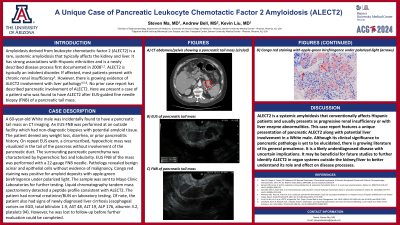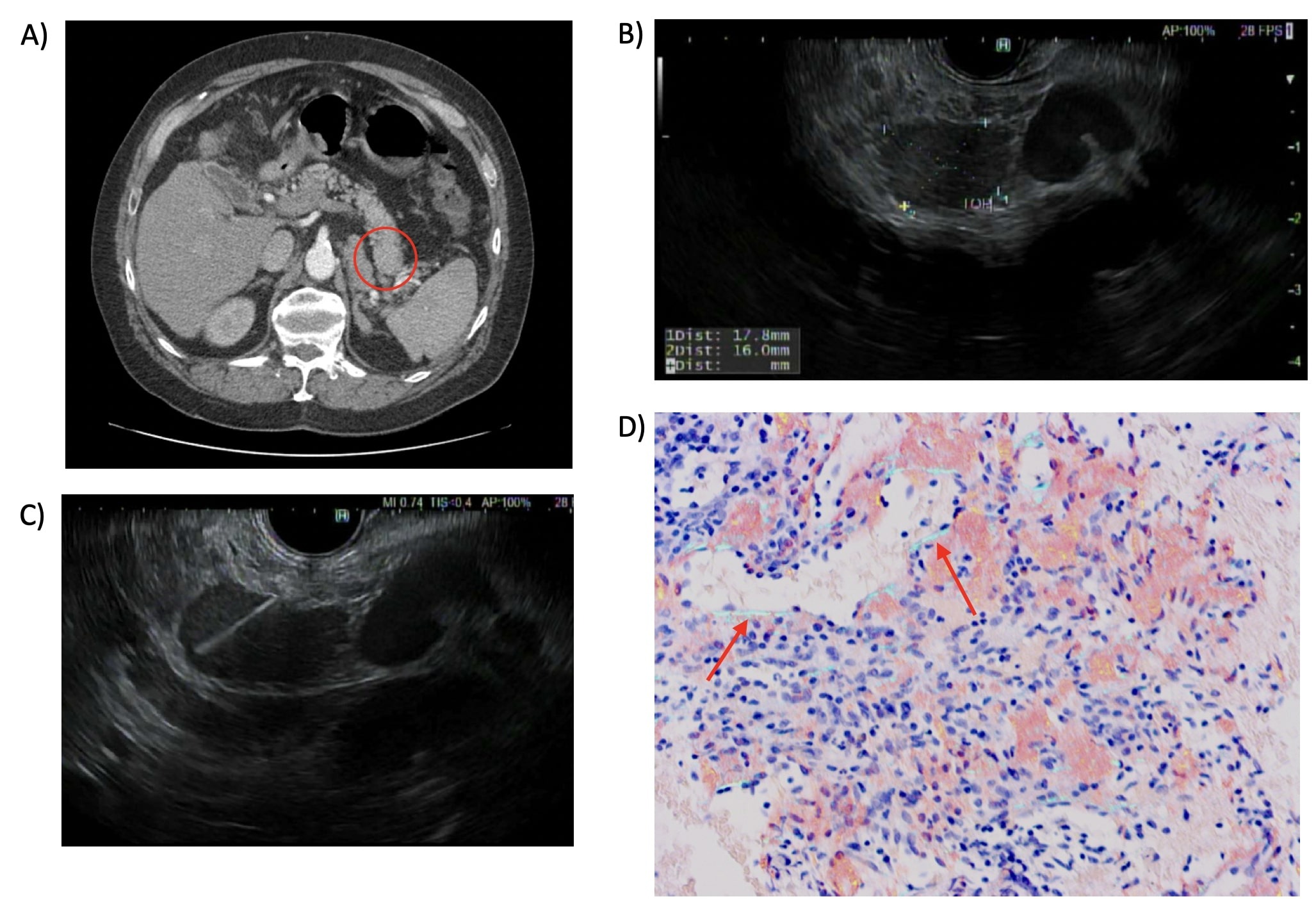Sunday Poster Session
Category: Biliary/Pancreas
P0090 - A Unique Case of Pancreatic Leukocyte Chemotactic Factor 2 Amyloidosis (ALECT2)
Sunday, October 27, 2024
3:30 PM - 7:00 PM ET
Location: Exhibit Hall E

Has Audio

Steven D. Ma, MD
University of Arizona College of Medicine, Banner University Medical Center
Phoenix, AZ
Presenting Author(s)
Steven D. Ma, MD1, Andrew Bell, MS2, Kevin Liu, MD1
1University of Arizona College of Medicine, Banner University Medical Center, Phoenix, AZ; 2Digestive Health Institute & Advanced Liver Disease and Liver Transplant Center, Banner University Medical Center, Phoenix, AZ
Introduction: Amyloidosis derived from leukocyte chemotactic factor 2 (ALECT2) is a rare, systemic amyloidosis that typically affects the kidney and liver. It has strong associations with Hispanic ethnicities and is a newly described disease process first documented in 2008. ALECT2 is typically an indolent disorder. If affected, most patients present with chronic renal insufficiency. However, there is growing evidence of ALECT2 involvement with liver pathology. No prior case report has described pancreatic involvement of ALECT2. Here we present a case of a patient who was found to have ALECT2 after EUS-guided fine needle biopsy (FNB) of a pancreatic tail mass.
Case Description/Methods: A 60-year-old White male was incidentally found to have a pancreatic tail mass on CT imaging. An EUS FNB was performed at an outside facility which had nondiagnostic biopsies with potential amyloid tissue. The patient denied any weight loss, diarrhea, or prior pancreatitis history. On repeat EUS exam, a circumscribed, hypoechoic mass was visualized in the tail of the pancreas without involvement of the pancreatic duct. The surrounding pancreatic parenchyma was characterized by hyperechoic foci and lobularity. EUS FNB of the mass was performed with a 22-gauge FNB needle. Pathology revealed benign acinar and epithelial cells without evidence of malignancy. Congo red staining was positive for amyloid deposits with apple-green birefringence under polarized light. The sample was sent to Mayo Clinic Laboratories for further testing. Liquid chromatography tandem mass spectrometry detected a peptide profile consistent with ALECT2. The patient had normal creatinine/BUN on laboratory testing. Of note, the patient also had signs concerning for a new diagnosis of liver cirrhosis. However, he was lost to follow-up before further evaluation could be completed.
Discussion: ALECT2 is a systemic amyloidosis that conventionally affects Hispanic patients and usually presents as progressive renal insufficiency or with liver enzyme abnormalities. This case report features a unique presentation of pancreatic ALECT2 along with potential liver involvement in a White male. Although its clinical significance to pancreatic pathology is yet to be elucidated, there is growing literature of its general prevalence. It is a likely underdiagnosed disease with uncertain implications. It may be beneficial for future studies to further identify ALECT2 in organ systems outside the kidney/liver to better understand its role and effect on disease processes.

Disclosures:
Steven D. Ma, MD1, Andrew Bell, MS2, Kevin Liu, MD1. P0090 - A Unique Case of Pancreatic Leukocyte Chemotactic Factor 2 Amyloidosis (ALECT2), ACG 2024 Annual Scientific Meeting Abstracts. Philadelphia, PA: American College of Gastroenterology.
1University of Arizona College of Medicine, Banner University Medical Center, Phoenix, AZ; 2Digestive Health Institute & Advanced Liver Disease and Liver Transplant Center, Banner University Medical Center, Phoenix, AZ
Introduction: Amyloidosis derived from leukocyte chemotactic factor 2 (ALECT2) is a rare, systemic amyloidosis that typically affects the kidney and liver. It has strong associations with Hispanic ethnicities and is a newly described disease process first documented in 2008. ALECT2 is typically an indolent disorder. If affected, most patients present with chronic renal insufficiency. However, there is growing evidence of ALECT2 involvement with liver pathology. No prior case report has described pancreatic involvement of ALECT2. Here we present a case of a patient who was found to have ALECT2 after EUS-guided fine needle biopsy (FNB) of a pancreatic tail mass.
Case Description/Methods: A 60-year-old White male was incidentally found to have a pancreatic tail mass on CT imaging. An EUS FNB was performed at an outside facility which had nondiagnostic biopsies with potential amyloid tissue. The patient denied any weight loss, diarrhea, or prior pancreatitis history. On repeat EUS exam, a circumscribed, hypoechoic mass was visualized in the tail of the pancreas without involvement of the pancreatic duct. The surrounding pancreatic parenchyma was characterized by hyperechoic foci and lobularity. EUS FNB of the mass was performed with a 22-gauge FNB needle. Pathology revealed benign acinar and epithelial cells without evidence of malignancy. Congo red staining was positive for amyloid deposits with apple-green birefringence under polarized light. The sample was sent to Mayo Clinic Laboratories for further testing. Liquid chromatography tandem mass spectrometry detected a peptide profile consistent with ALECT2. The patient had normal creatinine/BUN on laboratory testing. Of note, the patient also had signs concerning for a new diagnosis of liver cirrhosis. However, he was lost to follow-up before further evaluation could be completed.
Discussion: ALECT2 is a systemic amyloidosis that conventionally affects Hispanic patients and usually presents as progressive renal insufficiency or with liver enzyme abnormalities. This case report features a unique presentation of pancreatic ALECT2 along with potential liver involvement in a White male. Although its clinical significance to pancreatic pathology is yet to be elucidated, there is growing literature of its general prevalence. It is a likely underdiagnosed disease with uncertain implications. It may be beneficial for future studies to further identify ALECT2 in organ systems outside the kidney/liver to better understand its role and effect on disease processes.

Figure: Figure 1: A) CT abdomen/pelvis showing a pancreatic tail mass (circled); B) EUS of pancreatic tail mass; C) FNB of pancreatic tail mass; D) Congo red staining with apple-green birefringence under polarized light (arrows)
Disclosures:
Steven Ma indicated no relevant financial relationships.
Andrew Bell indicated no relevant financial relationships.
Kevin Liu indicated no relevant financial relationships.
Steven D. Ma, MD1, Andrew Bell, MS2, Kevin Liu, MD1. P0090 - A Unique Case of Pancreatic Leukocyte Chemotactic Factor 2 Amyloidosis (ALECT2), ACG 2024 Annual Scientific Meeting Abstracts. Philadelphia, PA: American College of Gastroenterology.

